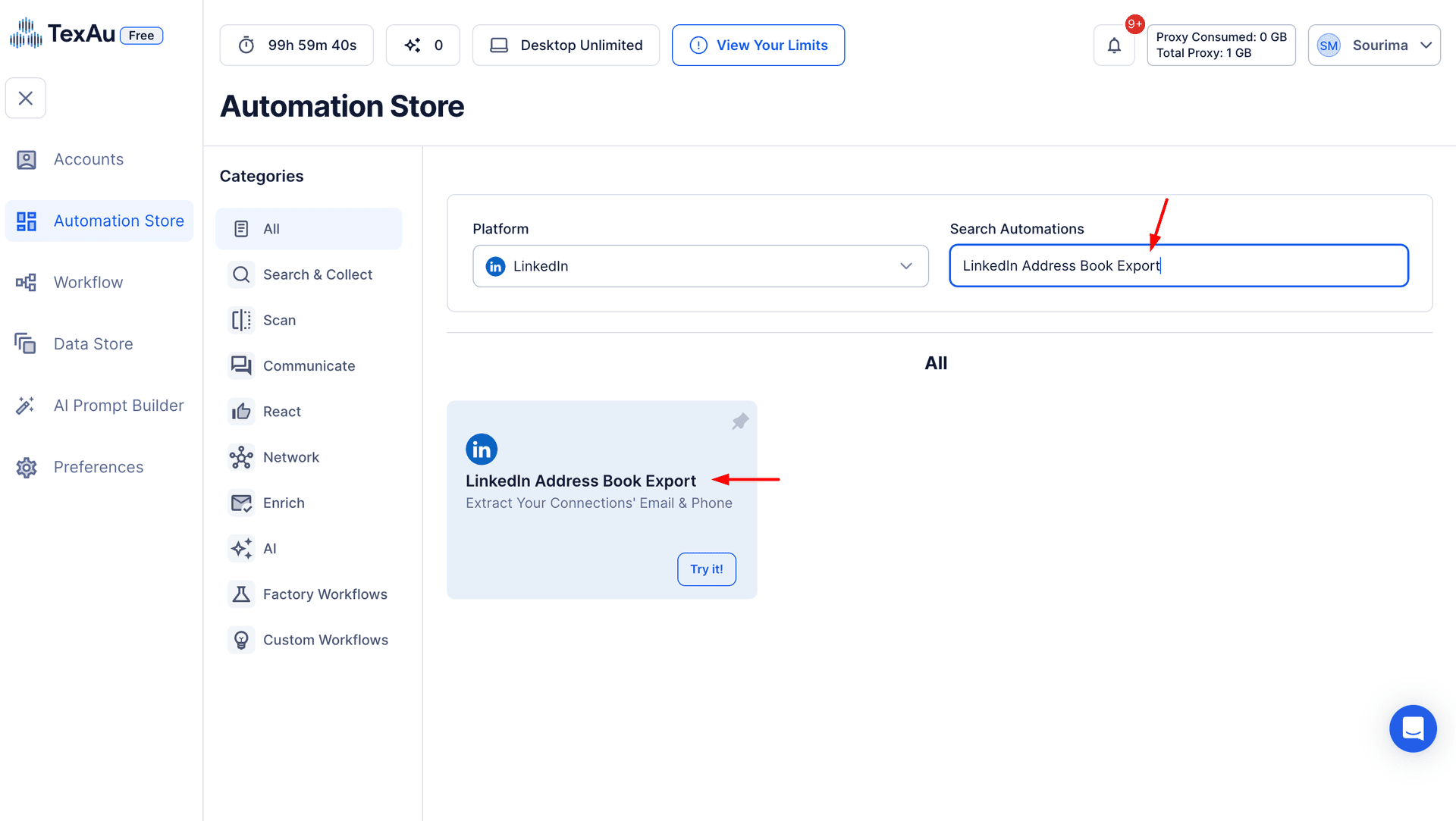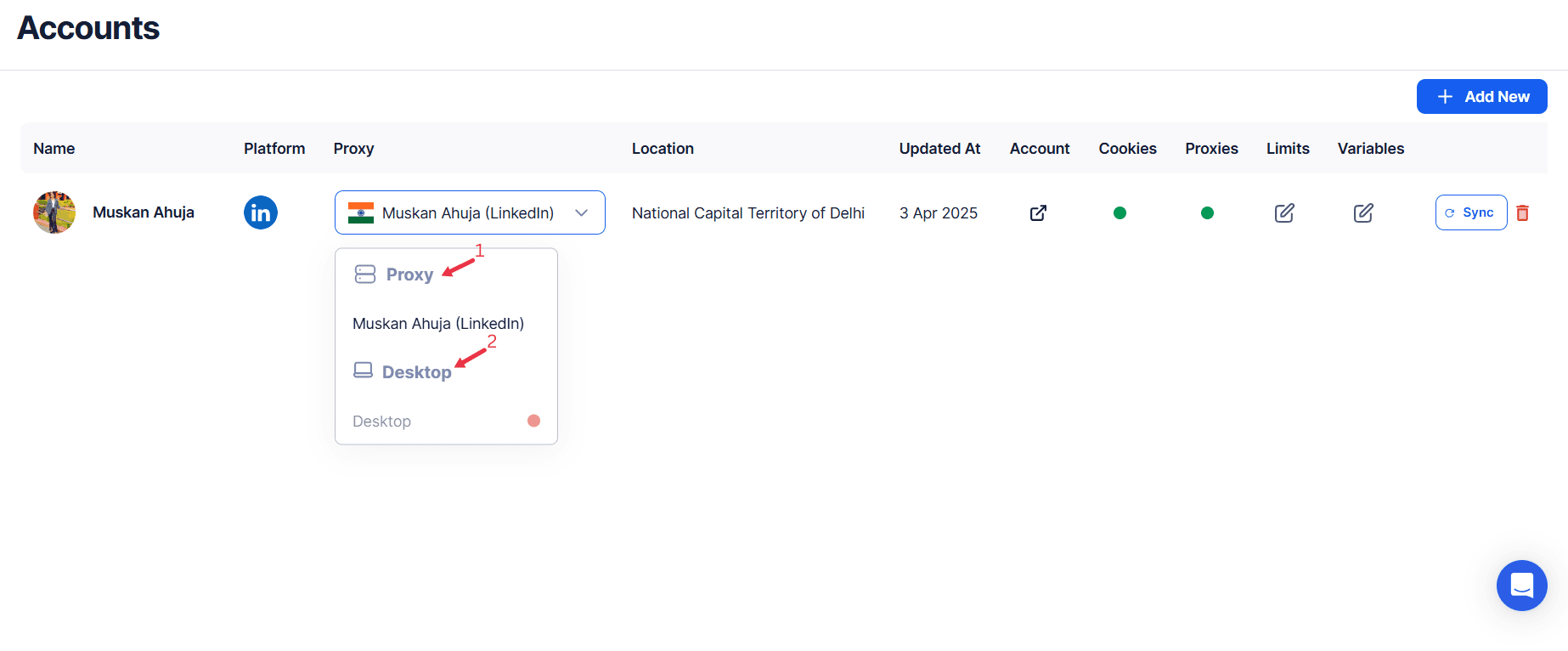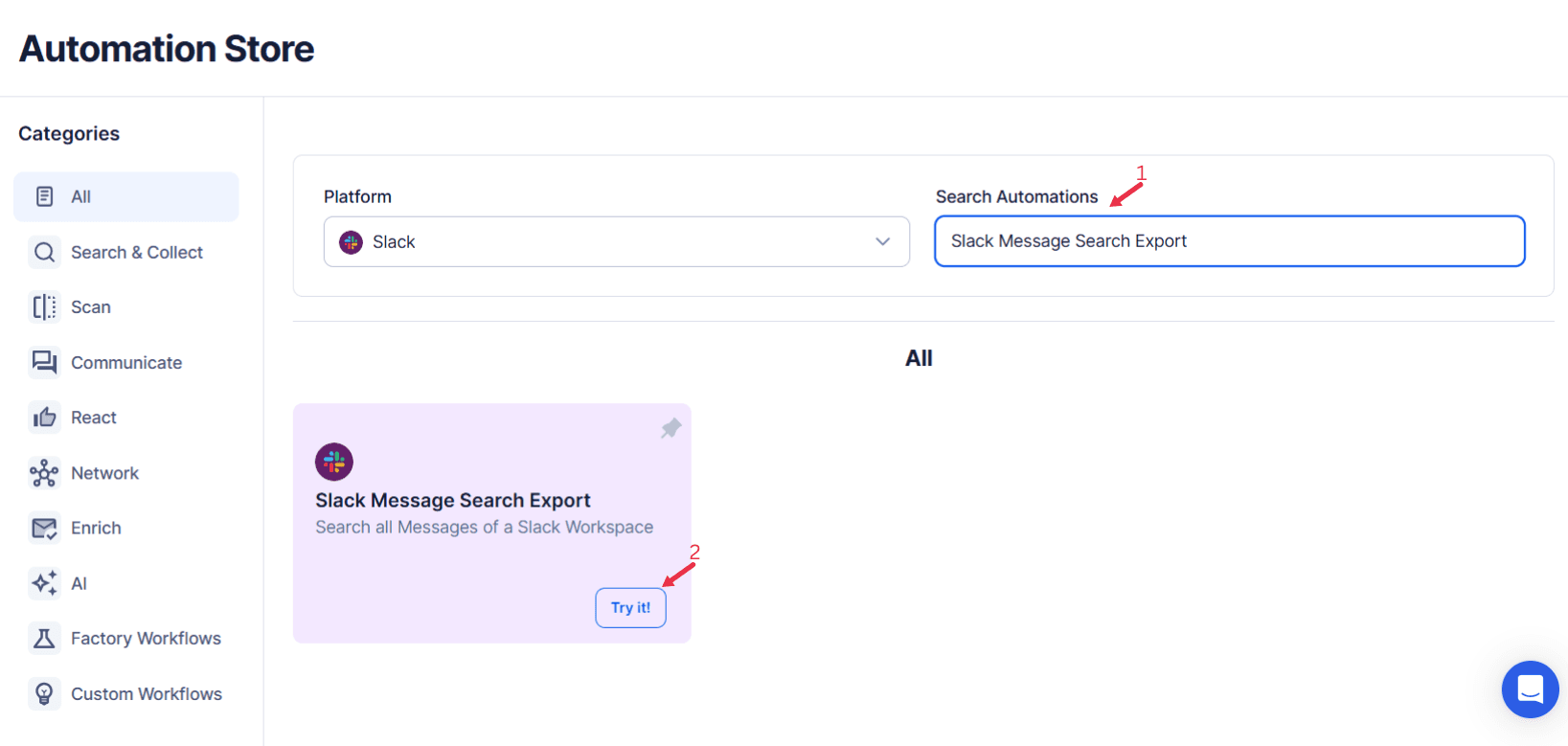Slack Message Search Export
TexAu's Slack Message Search Export automation makes it easy to extract Slack messages tailored to your search criteria. This tool is ideal for founders, sales managers, and marketers seeking to analyze conversations or track important topics. Export organized data to Google Sheets or CSV files, and utilize features like scheduling, iteration delay, and cloud execution for efficient workflows. Follow the guide to set it up smoothly.
Tutorial
Overview
The Slack Message Search Export automation allows you to extract and organize Slack messages based on specific search criteria, making it easier to analyze conversations and track important discussions. This tool is ideal for founders, sales managers, marketers, growth hackers, and companies looking to streamline their workflows. You can export data directly to Google Sheets or as a CSV file for further analysis. Follow this guide to configure the automation effectively, including the use of TexAu's desktop app, cloud execution, and advanced options like scheduling, iteration delay, and output modes.
Step 1: Log in to TexAu and Connect Slack Account
- Log in to your TexAu account at v2-prod.texau.com.
- Go to Accounts and connect your slack account. You can choose one of these methods:
- Share via Magic Link: Share the link, copy it to your browser, and follow the steps to integrate your slack account securely.
- Add Account: Sync cookies and browser data with TexAu for seamless integration.
Tip: Use Magic Link for an easy and secure connection.

Step 2: Choose Cloud or Desktop Execution
- Decide how you want to run the automation:
- Cloud Mode: Automates tasks on TexAu’s servers with built-in proxies. You can add custom proxies via Settings > Preferences > Proxies.
- Desktop Mode: Runs automation on your local device using your IP address.
Tip: Desktop mode saves cloud runtime credits and gives more control over the process.

Step 3: Search for the Particular Github Automation
- Navigate to the Automation Store on TexAu.
- Use the search bar to find Slack Auto Message automation.

Step 4: Select Your Input Source
The Slack Message Search Export automation allows users to search for specific keywords across Slack messages within a selected workspace. You can customize your search by specifying the workspace, keywords, and extraction limit for messages.
Single Input
This option lets you search for messages within a single Slack workspace using specific keywords.
- Account: Choose the Slack account where the search will be conducted.
- Slack Workspace: Select the Slack workspace where the messages will be searched.
- Search Keywords: Enter the keywords for searching messages.
- Extract Limit (Optional): Specify the number of messages to extract (max limit is 5000).
Google Sheets
Use this option for multiple keywords or workspace searches stored in a spreadsheet.
- Select Google Account: Link your Google account or select an existing one. Add a new account if needed.
- Select Your Spreadsheet: Click "Open Google Drive" to locate the Google Sheet. Choose the specific spreadsheet and sheet where the search data is stored.
- Processing Options:
- Number of Rows to Process (Optional): Set the number of rows to process.
- Number of Rows to Skip (Optional): Define how many rows to skip before processing.
- Slack Workspace and Keywords: Allow multiple inputs for Slack workspace selection and keyword entry.
- Extract Limit (Optional): Set extraction limits for each entry.
Loop Mode (Optional)
- Turn on Loop Mode to reprocess the Google Sheet from the start once all rows are completed.
Watch Row (Optional)
Watch Row feature detects new rows in Google Sheets and triggers workflows automatically, reducing manual workload.
Configure Watch Row by selecting an execution interval and setting an end date.
Watch Row Schedule
- None
- Scheduling Intervals (e.g., every 15 minutes, every hour)
- One-Time Execution
- Daily Execution
- Weekly Recurrence (e.g., every Tuesday and Friday)
- Monthly Specific Dates (e.g., 12th and 30th)
- Custom Fixed Dates (e.g., April 19)
By default, Watch Row runs every 15 minutes and continues for five days unless modified.
With Watch Row, TexAu ensures workflows stay dynamic and automated.
Process a CSV File
For static lists of Slack workspaces and keywords.
- Upload the File: Click "Upload CSV File" and select the file containing the Slack workspace and keyword data. Ensure the data includes the required fields.
- Adjust Processing Settings:
- Number of Rows to Process (Optional): Specify the number of rows to process.
- Number of Rows to Skip (Optional): Skip a defined number of rows from the start of the file.
Step 5: Schedule the Automation (Optional)
Configure the schedule to run the automation at specific intervals, keeping your Slack message exports up to date. Click Schedule and choose from the following options:
- None
- At Regular Intervals (e.g., every 4 hours)
- Once
- Every Day
- On Specific Days of the Week (e.g., every Monday)
- On Specific Days of the Month (e.g., the 10th)
- On Specific Dates (e.g., January 1)
Tip: Scheduling is particularly useful for ongoing Slack activity monitoring and reporting.
Screenshot Suggestion: Show the scheduling interface with options for selecting start time and recurrence frequency.
Step 6: Set an Iteration Delay (Optional)
Simulate natural activity by configuring an Iteration Delay. Set the Minimum Delay and Maximum Delay to randomize the timing between each search or message extraction, ensuring compliance with Slack’s usage limits.
Tip: Adjust delays based on the size of the dataset to avoid hitting rate limits.
Screenshot Suggestion: Include a screenshot of the Iteration Delay settings, showing fields for Minimum Delay, Maximum Delay, and time units.
Step 7: Choose Your Output Mode (Optional)
Select how you’d like to save and manage the exported Slack messages. Options include:
- Google Sheets or CSV Export: Export data directly to Google Sheets or download it as a CSV file.
- Output Management:
- Append: Add new messages to the end of an existing file.
- Split: Create a new file for each run.
- Overwrite: Replace previous data with the latest extraction.
Tip: Use Google Sheets for real-time updates and collaborative reporting.
Screenshot Suggestion: Show the Output Mode selection screen with Google Sheets and CSV options highlighted.
Step 8: Access the Data from the Data Store
Once the automation is complete, navigate to the Data Store section in TexAu. Find the Slack Message Search Export automation and click See Data to view or download the exported Slack messages.
Screenshot Suggestion: Display the Data Store screen with the “See Data” button highlighted.
The Slack Message Search Export automation simplifies the process of retrieving Slack messages for analysis and record-keeping. With features like Google Sheets and CSV exports, customizable input sources, scheduling, and flexible output modes, this tool helps teams streamline their workflows and maintain organized communication logs.
Recommended Automations
Explore these related automations to enhance your workflow
Slack People Search Export
The Slack People Search Export automation simplifies user data extraction based on specific search queries within your Slack workspace. Perfect for founders, sales managers, and marketers, this tool helps identify team members, target individuals for campaigns, and manage communication efficiently. Automate searches, schedule updates, and export results to Google Sheets or CSV for streamlined analysis and collaboration.
Slack Profile Scraper
TexAu's Slack Profile Scraper automation extracts detailed information from Slack profiles, including names, titles, and contact details. Perfect for organizing team data, streamlining communication, or building outreach lists. Ideal for HR professionals, team leads, and marketers, TexAu simplifies data collection, helping you manage Slack profiles efficiently and enhance collaboration within workspaces.
Slack Thread Messages Export
The Slack Thread Messages Export automation by TexAu allows you to extract and organize thread messages from your Slack workspace. Ideal for founders, marketers, and growth hackers, this tool helps analyze conversations, document key discussions, and monitor collaboration trends. Automate routine tasks, schedule updates, and export data directly to Google Sheets or CSV for seamless data management. Save time and enhance productivity with TexAu’s cloud or desktop execution options.

Start your 14-day free trial today, no card needed
TexAu updates, tips and blogs delivered straight to your inbox.

